Trend-watchers typically pay close attention to the media and tech habits of Millennials (people aged 20-33) and Generation Z (those aged 14-19). Where these audiences go, others tend to follow.
Recent studies from Deloitte, GlobalWebIndex and others, offer us fresh insights into the behaviours and preferences of this tech-savvy audience. Based on their research, here are five global trends worth noting.
1. We’re all social networkers now
“Globally,” GlobalWebIndex reported, “around 1 in every 3 minutes spent online is devoted to social networking and messaging, with digital consumers engaging for a daily average of over 2 hours (rising to 2 hrs 40 mins among 16-24s).”
These findings, based on a survey of over 50,000 internet users from around the world, reveals the near ubiquitousness of the social experience; 94% of online users have at least one social media account.
“The average internet users now has about 8 social accounts,” GWI found, “up from only 3 in 2012.”
That we tend to have more social media accounts - – as well as efforts to increase the stickiness of the social experience – is clearly one reason for a growth in the time spent on social networks.
However, the data also reflects that social networks are changing our media habits too.
Interestingly, “filling up spare time” was identified as the leading reasons for social media usage among 16-24s, a role in the past that might have been taken-up by TV. This highlights how quickly social networks have become the default media activity for younger audiences.
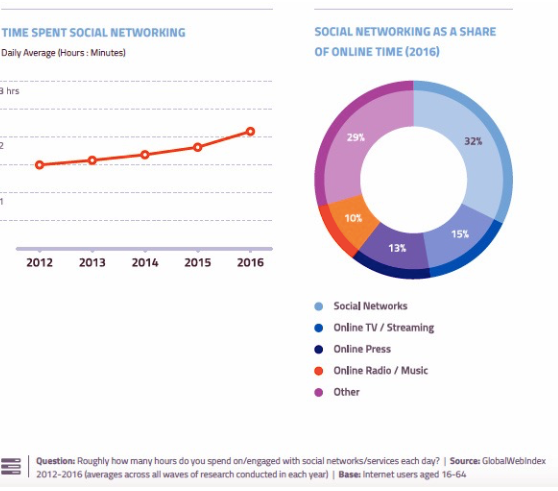
2. Instagram is now bigger than Twitter
The visual social network now enjoys a larger reach than Twitter, GlobalWebIndex reports, with Instagram also comfortably trumping its older rival in the key 16-34 age group.
With Facebook, Facebook Messenger and WhatsApp all continuing to enjoy high levels of daily usage around the globe, Mark Zuckerberg (Facebook owns both Instagram and WhatsApp) can rest relatively easy at night.
That said, Snapchat is the most popular messaging app with Gen Z in the US, a finding which no doubt continues to influence the increasingly Snap-like functionality that we are seeing across many of Facebook’s mobile products.
Applications, like face filters on Facebook Messenger and the launch of Facebook Stories, show just how influential Snapchat has been on shaping Facebook’s evolution.
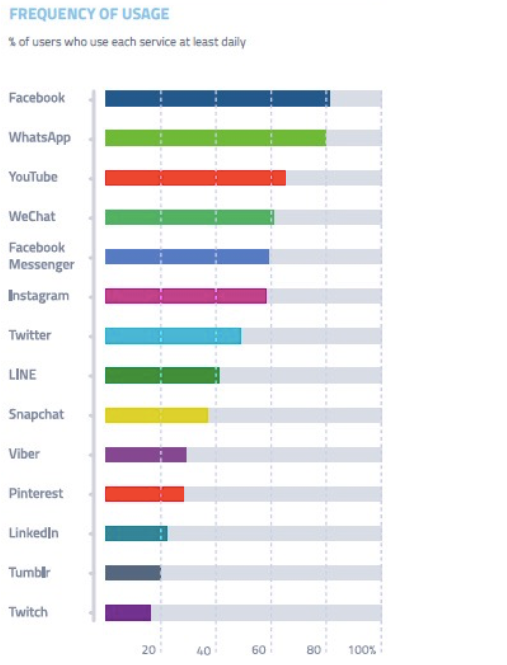
3. Watching video online is now pretty standard
Among all internet users (aged 16-64), 92% watch video clips online each month, GWI revealed, with just under half watching live TV, online TV/movies, and 53% watching sports online.
This pastime is bigger than usage of online radio (46%) and podcasting (36%), although both of these activities lag behind online gaming (undertaken by 63% of internet users in the last month) and music streaming (62%).
Viewing of TV online is even more popular with younger demographics. According to GWI’s global sample, 71% of 16-24s - and 73% of 25-34s - have done this in the past month, as traditional TV habits become increasingly redundant.
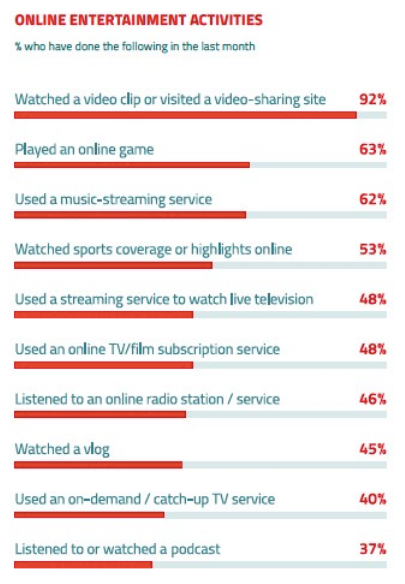
4. Gen Z has quickly become the Netflix generation
In North America, 70% of Generation Z (those aged 14-19) watches Netflix each month, GWI observed, and worldwide, 25% of all Gen Z watches Netlifx. This compares against a global average, for all age groups, of 1 in 4.
Because of this, it’s no surprise that Gen Zers watch more online TV than other demographics, averaging 1 hour 11 minutes a day.
But, traditional TV viewing amongst this cohort isn’t dead yet. They still watch 20 minutes more – 1 hour 31 mins – of traditional TV, in addition to their online TV habit.
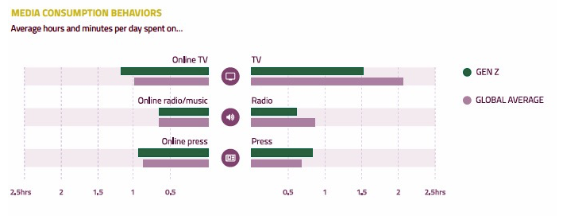
5. Younger audiences love to binge
Love of on-demand services may also be one of the reasons why, Deloitte found, Gen Z and Millennials in the US are also more likely to be binge-watchers. Although it’s a habit that all age groups have embraced.
In the press release for their latest Digital Democracy Survey, Deloitte noted that 40 percent of millennial and Gen Z binge watchers do so weekly; and that Gen Z and millennials spend about half their time watching television shows and movies on devices other than a TV.
Meanwhile, the main report finds that this group averages a staggering 6 episodes – or 5 hours – of viewing in a typical binge-session.
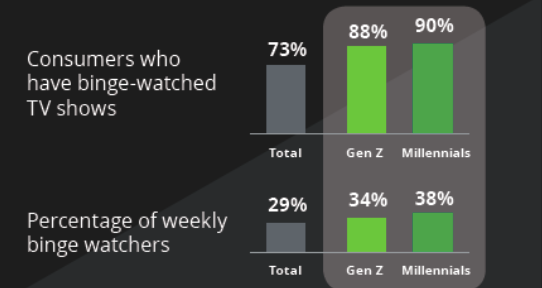
This tendency to binge isn’t unique to the US. Research published in the summer by the UK communications regulator, Ofcom, found that c.10 million Britons, 32%, have lost sleep or are tired the next day due to staying up too late binge-watching TV.
Meanwhile, the decision to simulcast recent series of Game of Thrones (broadcast at 2am in the UK and 9pm, on the eastern seaboard of the States) no doubt led to some even more caffeinated Monday mornings for hardcore fans.
Winter is coming then for many traditional media players, as tech platforms increasingly reshape the media diets of all age groups. With on-demand video and use of social networks now part of our typical night’s watch, there isn’t a wall big enough to hold back their advancement.
